The 17th High-Life Seminar: Eco-city contest
The 17th High-Life Seminar: Minutes
Eco-city contest
Seven proposals to change Japan from its regions
Seminars to commemorate publication in Tokyo and Kyoto
Organizers:
Research Institute for High-Life
The National Eco-City Contest Network
Citizens Environment Foundation, specified nonprofit corporation
Tokyo venue
Time: Friday, March 6, 2009. 13:30 to 17:00
Place: Kodama Hall
Kyoto venue
Place: Mielparque Kyoto
Time: Monday, March 9, 2009. 13:00 to 16:30
Seminar venue in Tokyo Seminar venue in Kyoto
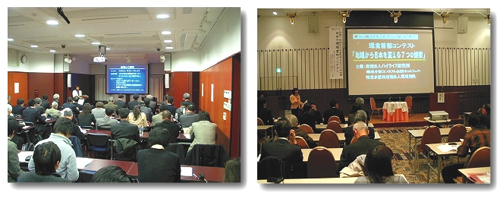
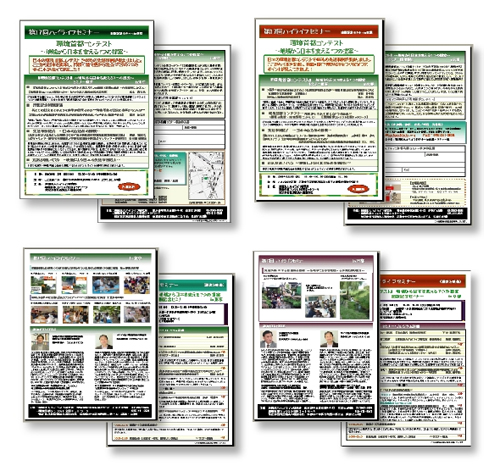
Minutes of lectures
“Seven proposals to change Japan from its regions”: Purposes and contents of the book
Lecturer: Mr. Ikuo Sugimoto (President of NPO Citizens Environment Foundation) (Representative of the National Eco-City Contest Network)
http://www.kankyoshimin.org/
Profile of the lecturer: Ikuo Sugimoto
Graduate of the Faculty of Agriculture of Kyoto University. Established the Citizens Environment Foundation with various people and experts engaged in environmental issues in 1992. Published “Green Consumer: Tips for Shopping for the Earth’s Ecology”, “Visiting the World’s Eco-cities” (co-author), Iwanami Junior Shinsho (2002) , and many others.
Unsustainable society and development
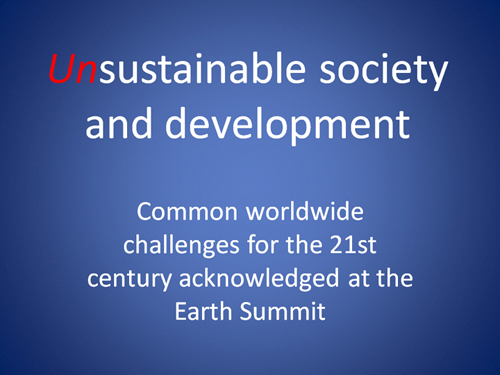
We held the Eco-City contest with the hope of realizing sustainability in our society and development as early as possible in the 21st century.
Although sustainable society and development have become the hottest key words today, we unfortunately have no other choice but to acknowledge that our current society is unsustainable. If our society were not unsustainable, there would be no need for us to even mention such a thing.
Our society has been unsustainable mainly in terms of the environment, but I believe that aspects such as the environment, resources, food, water, population, poverty, conflict, and economics are all affected. Unfortunately, all of these aspects mentioned above have been moving in the wrong direction.
If there were movement in the right direction in even just one of these aspects, it might be possible to resolve the situation, but unfortunately, this is not the case.
In addition, all of these phenomena are caused by actions taken by us humans. We have no choice but to consider that these are in no way natural phenomena and that we humans are the ones making our own societies unsustainable.
Sustainable development
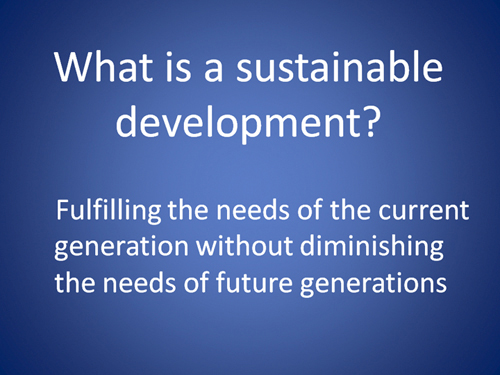
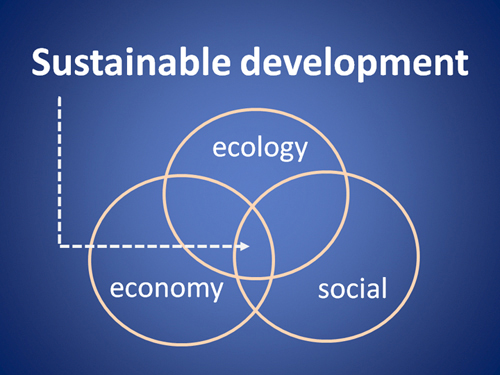
Sustainable development refers to “fulfilling the needs of the current generation without diminishing the needs of future generations”.
It can also be described based on three circles (refer to Figure). When considering the environment, the economy, and society, if we look at the phenomenon of “global warming” that affects the “environment”, the term “global warming” appears on TV and in commercials throughout Japan everyday and it seems that Japan is one of the leading country that have expressed interest in preventing global warming. Although awareness and public information have been increasing, unfortunately, this has not meant that the amount of greenhouse gases has decreased; rather, it has actually been increasing. In terms of the “economy”, the collapse of financial capitalism in 2008 has led to a worldwide economic crisis, and we have entered the worst economic situation in history.
In addition, I have translated one item as “social justice”, but this is a concept that includes welfare, human rights, social security, and regional identities in English. Although Japanese society has also tried to improve these aspects after the war, we are now entering another period of collapse. Moreover, looking at the world, the conflicts between the North and South have been intense and the disparity in wealth has become wider.
Our society is based not on sustainable development, where all three aspects of environment, economy, and society overlap, but on a situation in which these circles have become disengaged.
I believe our society will not survive long in this situation. I believe now is the time to change and create change as stated by President Obama.
Agenda 21
When thinking of where we need to change first, I think there is one major point that we should consider, and that is the document “Agenda 21”, which was established at the so-called Earth Summit held in Rio de Janeiro, Brazil in 1992. This “Agenda 21”, which lists challenges for the 21st century, is the most important document from the Earth Summit. Chapter 28 states that many of the various issues and solutions proposed in “Agenda 21”are rooted in local activities, and therefore, the participation and cooperation of local public authorities is a decisive element for achieving its goals. That is, this U.N. document states that whether or not we can create sustainable societies for our world depends on local governments throughout the world. I believe that while governments and businesses certainly play important roles, we must not overlook the role of local governments. In Japan, I feel that this is not acknowledged very much, but change in Japan will in fact start from the regions. We believe that the regions are truly the basis of not only the environment but also for building a livable, economically stable, and equitable society.
Changes in government policies start from the regions
This can be explained starting from the various points, but I want you to remember one thing: changes in government policies are essential for building a sustainable society, but they never occur easily at the national level. I am certain that it is possible that change will occur first in the regions.
Regarding the environment, there has been pollution, such as the four major industrial pollutions and road-related pollution, and great damage in the past. The local governments in each region started to get involved spontaneously in order to stop the damage from spreading. They did so because they had to and because they had no choice but to get involved because there were no laws deal with the situation. The efforts made by the local governments generated significant results while also receiving supports from local citizens, with the Basic Act for Environmental Pollution Control and 14 applicable laws and regulations enacted in the Diet in November 1970. This has led to the establishment of the Environment Agency. I believe that changes in major government policy start from the regions. I also believe that the next session of the Diet should focus not only on measures for controlling environmental pollution but also on creating a sustainable society. However, I believe that the Japanese government is not quite moving toward that direction. Even in this respect, we must continuously raise our regional voices.
Learning about eco-city contests
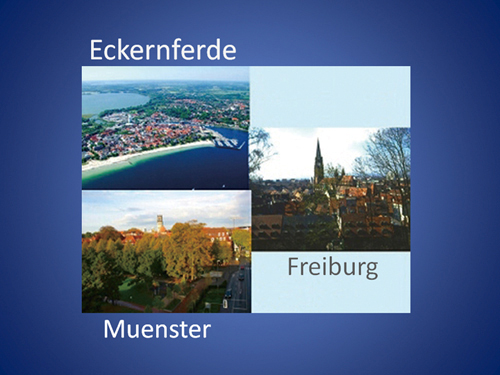
In the mid-1990s, we learned about the eco-city contest held in Germany. Freiburg then became known in Japan, and other cities in Germany making truly interesting efforts have started to become popular at the eco-city contest in Germany.
When I asked about the purpose of this contest at that time, I was told that it was a “competition as a strategy”. That is, the contest was held to make not only the local governments but also the entire German nation improve through competition. We thought that a similar contest should be held in Japan, and after making further preparations, we have been holding the national eco-city contest since 2001.
The objective of the contest is the same: to make Japanese society sustainable. For this purpose, we should bring in a structure that supports regions, especially regions taking the initiative in making efforts, and further improves them through competition. These are the objectives of the eco-city contest in Japan.
The town I am showing now is the one that became the eco-city in Germany.
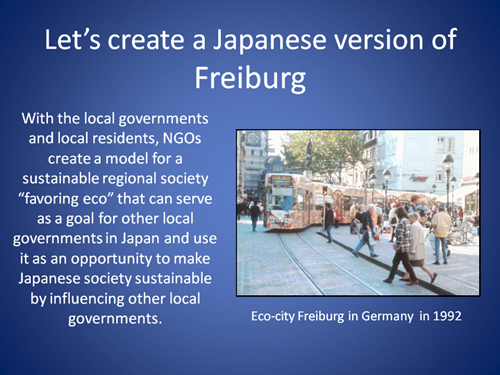
Eco-city contests in Japan
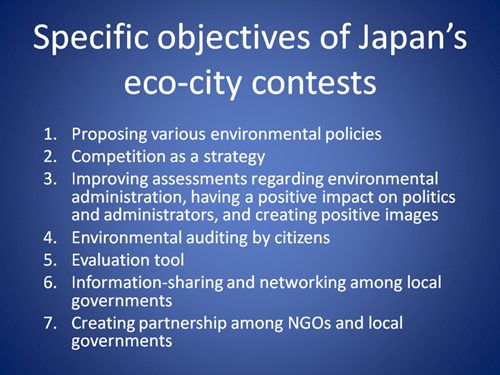
In other words, we have been using the term “favoring eco”, but we would like to create local governments in Japan that are sharp in many ways. I want all local governments to become sharp to raise the entire nation. With this hope, we have started this contest since 2001.
Looking at each of the objectives of the contest separately, one of the objectives is to propose environmental policies. In this contest, we submit over 200 pages of questionnaires to the participating local governments. Although we refer to it as a questionnaire, it is actually policy proposals.
We prepare and propose actions that the local governments in each region should attempt. The answers to the questions, which are the proposals, are then collected, and therefore, the system is also designed so that local governments agree with and implement our proposals in order to obtain good scores at this contest.
Other objectives include “competition as a strategy” and “improving assessments regarding environmental administration as a whole”. In the case of Japan, because environmental administration is still handled at the lower levels within the ministries and agencies, there is a trend in which a similar ranking system exists even among the local governments. For some reason, the environmental departments tend not to rise up the ladder of the system. I think that we must immediately try to place the environmental departments at higher levels within both the local governments and the regions. Furthermore, environmental audits conducted by citizens can also be implemented. We believe that these can then become tools for the local governments to discover the advantages and challenges of their own regional societies through comparisons with the other local governments.
Questionnaire
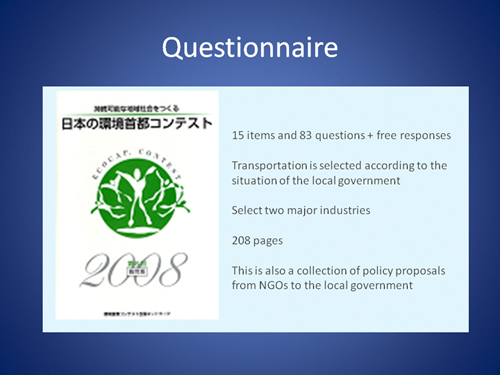
On A4 paper, the questionnaire is 208 pages long. I think you will see that rather than asking about the environment in a narrow sense, half of the questionnaire asks about challenges faced by the local government and the regional society along an entire spectrum of environmental issues.
Many local governments will spend one or two months answering the remaining half. Moreover, they need to contact and organize with most departments of the local government in order to provide answers, so I believe they are questions regarding policies for a sustainable regional society based on the environment, rather than simply questions regarding the environment.
The contest is held every year and we analyze the results in various ways, creating many cobweb charts and sending them to the local governments to provide reference for developing their next policies. We summarize these results in a report.
Praising local governments
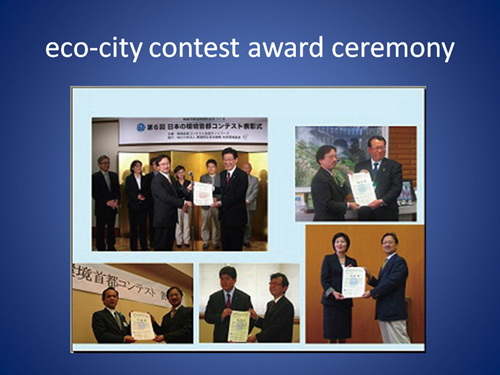
One of the very important aspects of the contest is to praise good local governments. Japan should be a society where people can simply say something that is good is good.
In our contest, we award prizes to the top ten overall local governments. We also award prizes for individual departments and top-scoring local governments according to population size. We also commend the leading examples because we think Japan will be better if we advance our efforts. We conduct an award ceremony directly with the mayor or town mayor in each region and receive a favorable reception from the leaders in each region. However, there are no cash prizes or gifts for the contest awards, and we give out only one piece of paper.
The local leaders are pleased because “they have to work very hard to answer the questions and NGOs and NPOs offer praise after properly analyzing the results”. That is, they usually receive complaints, rather than compliments, from NGOs and NPOs, and they all say “this is very good for the local governments”.
It is important for us that we have been not only offering praise but also offering opinions and exchanging information with the mayors, town mayors, and officials of the local governments.
Rather than being a process where we unilaterally make judgments and the local governments only receive judgments, I think a large part of the process is creating teams in which the local governments exchange information and try to improve by learning from others to change Japan even a little. We have held 8 contests from 2001 to 2008. People sometimes ask, “What can be changed with such a small number of participating local governments out of 1,800?”
However, the maximum participation rate in the eco-city contest in Germany, our predecessor, was actually not even 3%, but it is said that the contest still had a great impact. We are not trying to compare all of the local governments in Japan. What we want is for the various local governments to make their regions sustainable and their societies rich through their own efforts. This contest provides support for them to do so.
In that sense, our idea is that if sharp local governments are making efforts, the country will be boosted. Therefore, we believe that even this number of participating local governments is enough.
However, this cannot be done by our own organization alone, so we created the National Eco-City Contest Network. Tokyo participates in the “Institute for Sustainable Energy Policies” and “FoE Japan” while Kanagawa prefecture participates in “Regional Environment Citizens”, “Kanagawa Environmental Research & Education”, and Yamanashi prefecture participates in “Yamanashi Eco-Network”.
Proposals for various environmental policies
First, I will discuss the progress of our actual goals. For these proposals for environmental policies, we are getting response from many local governments saying, “Now we see what we can do and what we should do”. Many policies are implemented in various regions after learning that “it is very interesting to know that there are many ways to do things” from leading examples in order to mimic them and even improve on such policies. The number of such cases has been increasing, and we believe we are on the right track.
As a result, the average score of the participating local government has become higher. We have been trying to make the contest harder every year. We never ask the same questions but harder ones. If a participant’s efforts have not changed, they will get lower scores. I think the participating local governments have making a lot of efforts, and this is why the average score has been higher even though the questions are harder. We have been creating a collection of visual materials regarding leading examples with the Research Institute for Hi-Life and asking the local governments to use these materials. At meetings, information regarding the leading examples is exchanged among the local governments from various regions. They are also distributed via the Internet by the Research Institute for Hi-Life. I want you to understand that the contest involves questions regarding regional sustainable societies based on the environment.
We receive various opinions from the participating local governments. One of the opinions, for example, was that “this contest will be very useful when advancing the policies of the local government or creating partnerships”.
Competition as a strategy
We are hoping that the local governments will try to improve by learning from others and implementing better measures and policies in order to make their societies more sustainable through their activities. For example, mayors in some local governments with high rankings or rankings within the top 10 personally proclaim that their objective is to be an eco-city. Some local governments try to create specific measures for the development of an eco-city while creating departments having “eco-city” in its name, such as an Eco-City Promotion Office, or while stating that becoming an eco-city is a top objective in their general plans.
There are opportunities for mayors to gather where everyone says, “My city will be the next top eco-city”. I think this is really a competition in a good sense.
The 7th annual top 10 eco-cities are as follows:
- 1. City of Kita Kyushu
- 2. City of Minamata
- 3 City of Iida
- 4. City of Anjo
- 5. City of Shinshiro
- 6. City of Ube
- 7. Itabashi ward
- 8. City of Amagasaki
- 9. City of Tajimi
- 10. City of Toyota
I think we can point out some characteristics. One of the characteristics is that these eco-cities do not share similar demographic compositions, and the size of the city does not matter. I believe that bigger cities with large populations are not the only places where many effective policies can be created. The second characteristic is that half of the top 10 local governments, such as the city of Kita Kyushu, the city of Minamata, the city of Ube, Itabashi ward, and the city of Amagasaki, have had a hard time dealing with serious environmental pollution in the past. As a result, these local governments experiencing hard times are ranked higher for their environmental policies. That is, we can see that they are making a lot of efforts using their experiences as a springboard
Also, local governments having unique and very innovative mayors tend to be ranked higher.
I think those making an effort for civic participation and for partnerships tend to be ranked higher.
Information-sharing and networking among local governments
We want to enhance the networks among the local governments through this contest.
As a result, the city of Iida, for example, has invited the mayors or deputy mayors of the other top 10 local governments and held three seminars in a row. When the city of Minamata held the “World Lead-off City Conference”, they set “City development aiming to be an eco-city” as its theme. They intend to create a much better city based on the advantages of being an eco-city.
Partnerships between NGOs and local governments
We also consider the partnership between ourselves and the local governments. For instance, we hold annual meetings for each block, such as the Kanto region, where people can interact and learn about the leading examples from the local governments. “National Forum of Local Governments Aiming to be Eco-Cities” was the national meeting held in Iida in 2008. The leaders of the local governments, people involved in NPOs, and even local businesses attended and honestly discussed policies and strategies for two days. By repeating this process, I believe it can be a scheme in a good sense for somehow changing the Japanese society while involving NPOs, the local governments, and interested businesses. We would like to make this scheme bigger.
When holding this contest every year, we found quite a number of very interesting leading examples. We have made and distributed a simple booklet including 60 to 70 case examples every year that were used at the exchange meetings among the local governments. We were once asked if we could offer not only text information but also visual materials. With the Research Institute for Hi-Life, who has organized this seminar, we have been able to create a collection of visual materials regarding the leading examples of 2005, 2006, and 2007.
Seven proposals to create a sustainable society
After learning about these case examples and the results of the eco-city contests, we looked back at our original big challenge: what is the point of “creating a sustainable society from within the regions”?. After discussions with our team, asking scholars, talking with local governments, visiting persons involved in the eco-city contest in Germany, and holding various debates, we have reached these 7 proposals. They are merely proposals and are not conclusions.
I would like you to discuss whether these 7 proposals are good or not. We believe “these 7 points are important to change Japan and to change Japan from the regions”.
Based on these proposals, we have published a book containing many case examples. We would like you to know that there are some local governments that are actually implementing policies rather than just proposing them.
First of all, the most important thing is “making use of and creating human resources”. I certainly believe that we must spend more money and time on human resources. Japan has been spending more money on goods than on human resources, and I think this has harmed the local regions. I believe we need human resources (public human resources) that can look at the situations around them and work together while having leadership, rather than leaders who simply ask to be followed. I believe there is a true need for such human resources in various sectors. We need to consider generating “public human resources” in our assessments of policy, including the efforts made by regions, efforts made in areas of public administration by the local governments, and efforts with citizens and businesses toward creating public human resources. We also need to take the initiative on such policies.
The second point is “visualizing images for the future of the regions” through an initiative we call “BACKCAST”. In the case of Japan, policies are based on “FORCAST” and are only countermeasures. When we look at the responses to global warming, for instance, they are just countermeasures and are far from visualizing a society that can prevent global warming. Policies cannot be set strategically for realizing an image of such a society. As a result, the efforts made by the Japanese government to prevent global warming are small, and it is said that Japan is ranked at the bottom in a World Bank assessment. This is very shameful, but this is the situation, even though the name of “Kyoto” is used for the Kyoto Protocol. The key is visualizing an image for the future and working to achieve it.
The third point is “creating businesses strategically”, or to carry out businesses and policies strategically. This strategy is one of not dealing only with countermeasures and sets out “actions to take this year through forward-looking policies for 5 years and 10 years”. I think these are very important.
The fourth point is carrying out policies that integrate the three themes of sustainability: environment, economy, and society. We call these environmental policies or economic stimulus measures, but policies that integrate the environment and the economy, described now as the “Green New Deal” by President Obama, are fundamentally necessary. Furthermore, these policies implement social measures in areas including welfare and employment as well as environmental measures. When we consider this situation, and this is related to my third point, we see that public administration in Japan is traditionally mainly vertically structured. As long as this structure exists, each section is in charge of only specific fields: the environment for the environment section, regional development for the regional development section, the economy for the economy section, and welfare for the welfare section. I think this may be very pointless in the current situation with the lack of funds and human resources and its effects will be deteriorating. We must understand that in the future, both the Japanese government and regional societies must implement only policies that combine the environment, the economy, and society. In order to achieve this, we need to think about this in a deeper and broader manner than the Green New Deal.
The fifth point is deepening partnerships. First, it is impossible for only the government or for public administration to implement these efforts due to insufficient funds and human resources. Taking this into consideration, we must take advantage of the power of the people based on civic participation and dialogue, but this is very hard to do because partnerships are not that simple. Although it is easy not to do, it may generate a great synergistic effect if we do it. I would like this to be the basis for public administration.
The sixth point is “integrating public administration”. When considering this, we need to create horizontal connections rather than vertically divided systems of administration. Please look at case examples such as the city of Tajimi on our DVD.
The seventh point is “creating leading examples”. In order to mobilize people, visible case examples of “good changes and improvements in society” and “regions making progress” are needed. It is very difficult to change society, but we should create case examples one by one in order to show people that “this can be done, and these are the kinds of citizens who are participating” so that people can see the progression toward a sustainable regional society. I think this will give people courage.
We have made “seven proposals to create a sustainable society” by publishing this book. I want not only local and national public administrations but also regional societies and the entire society to think and refer to the “seven proposals to create a sustainable society”. These are merely proposals we have come up with, and we do not think they are necessarily the right answers.
We would like you to learn from the 17th Hi-Life seminar and read the book that we have published to provide us many constructive criticisms. We believe these are proposals for creating numerous debates on what we should do in order to reform this society and to build a truly better society in Japan and for putting policies into practice.
Conclusion
We have been holding our contest with the hope that something visible will be created to change Japanese society starting from each region based on your opinions, and this seminar is an example of such efforts.
I forgot to mention one thing.
We have referred to Japanese eco-cities, but there is no local government to which we have awarded the title of “Japan’s eco-city”.
In Germany, the top city in the eco-city contest instantly becomes the country’s eco-city, but in Japan, an eco-city must be ranked at the top, obtain more than 70% in their total score, and meet three requirements. This is why we still do not have an eco-city in Japan. However, many local governments are getting closer to the title, and I believe that a Japanese eco-city will be born this year or next year.
Seven proposals to create a sustainable society
- 1. Making use of and creating human resources
- 2. Visualizing images for the future for the regions
- 3. Creating businesses strategically
- 4. Integrating the environment, the economy, and society
- 5. Deepening partnerships
- 6. Integrating public administration
- 7. Creating leading examples